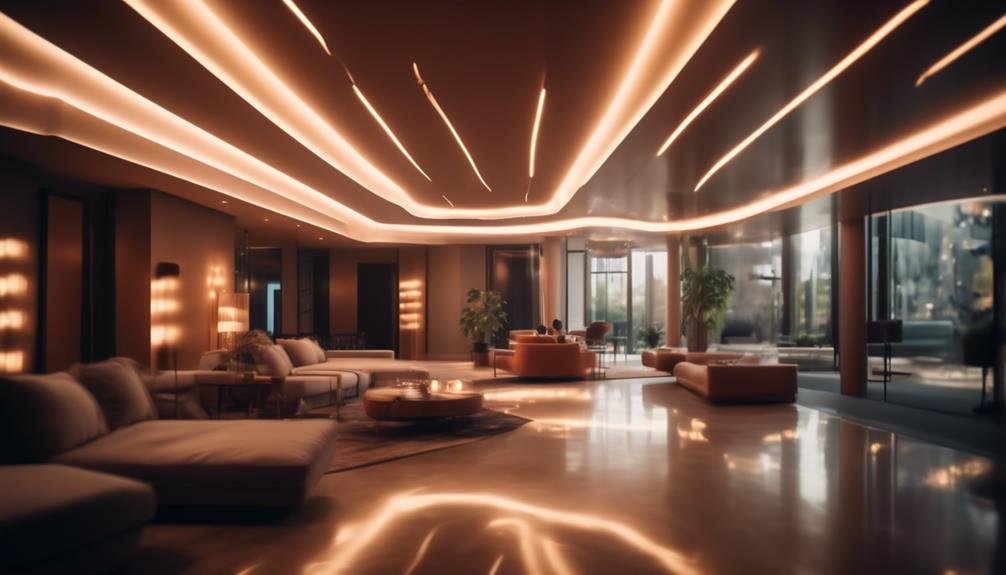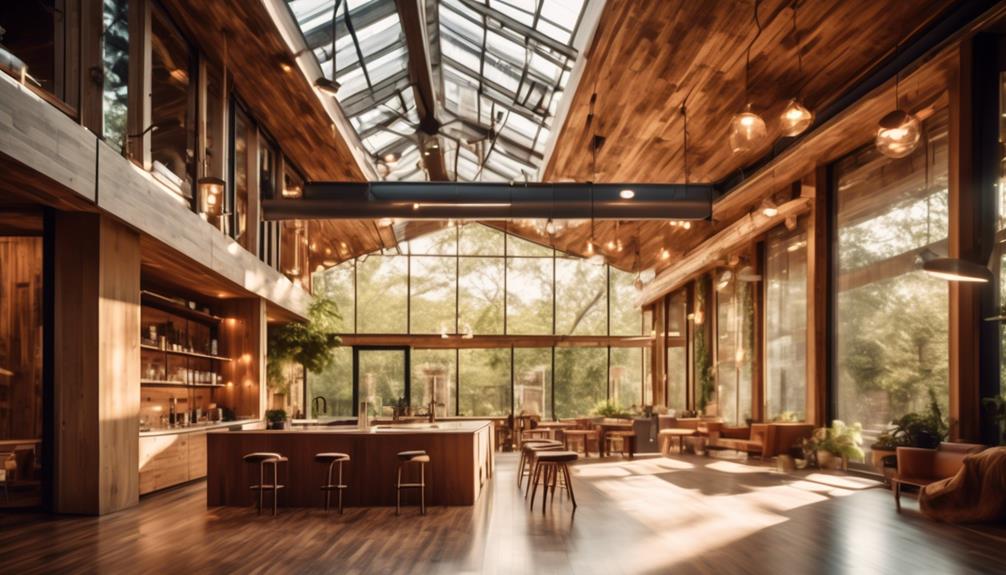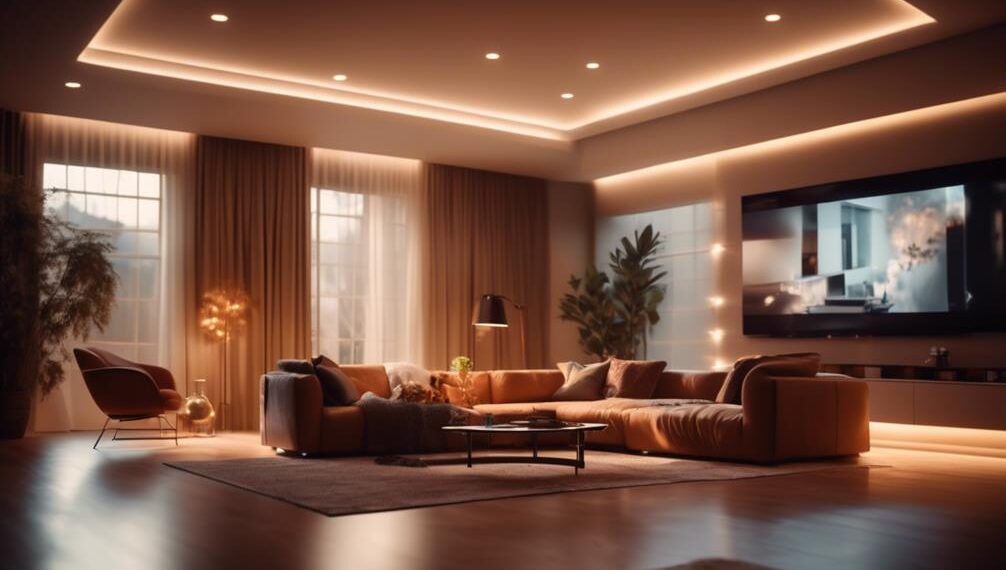As you step into the future, envisioning the architectural landscape of 2024, one cannot help but be captivated by the transformative power of light.
The interplay between light and space has always been integral to architectural design, and in the coming years, it is set to reach new heights. With advancements in technology and a growing focus on sustainability and human well-being, the trends in architectural lighting design best practices are poised to shape the way we experience and interact with the built environment.
From the integration of smart lighting systems to the use of dynamic lighting techniques, there is much to explore and discover in the realm of architectural lighting design in 2024.
Key Takeaways
- Integration of smart lighting systems offers cost-effective solutions by reducing energy consumption and lowering maintenance costs.
- Prioritizing energy efficiency in architectural lighting design through the use of energy-efficient fixtures and lighting controls helps reduce energy consumption and lower operating costs.
- Incorporating human-centric lighting principles promotes the well-being and health of individuals by considering the impact of light on their circadian rhythms and overall mood.
- The use of sustainable materials in architectural lighting design contributes to environmental sustainability and promotes a healthier and more sustainable future.
Integration of Smart Lighting Systems

When integrating smart lighting systems into architectural designs, it's crucial to consider both the technical aspects and the creative potential they bring to enhance the overall lighting experience. Smart lighting systems offer a range of benefits that can revolutionize the way we interact with our built environment.
One key advantage of integrating smart lighting systems is the ability to provide cost-effective solutions. Traditional lighting systems often consume a significant amount of energy, leading to high electricity bills. In contrast, smart lighting systems are designed to be energy-efficient and can be programmed to automatically adjust lighting levels based on occupancy or natural light availability. This not only reduces energy consumption but also lowers maintenance costs, making it an economical choice for architectural projects.
Another important feature of smart lighting systems is their wireless connectivity. With the advancement of technology, smart lighting systems can be controlled remotely through smartphone applications or integrated with other smart devices in a building. This wireless connectivity allows for seamless integration and control, providing users with the freedom to customize their lighting preferences according to their needs and preferences.
Emphasis on Energy Efficiency

To maximize energy efficiency in architectural lighting design, prioritize the implementation of smart lighting systems that offer energy-saving capabilities. Energy efficient fixtures and lighting controls are key components in achieving this goal.
Energy efficient fixtures are designed to consume less energy while providing the desired level of illumination. LED fixtures, for example, are known for their high energy efficiency, long lifespan, and low maintenance requirements. By incorporating these fixtures into your lighting design, you can significantly reduce energy consumption and lower operating costs.
In addition to energy efficient fixtures, lighting controls play a crucial role in enhancing energy efficiency. These controls allow you to adjust the lighting levels based on occupancy, natural daylight availability, and time of day. Occupancy sensors, for instance, can automatically turn off lights in unoccupied areas, ensuring energy isn't wasted. Dimming controls enable you to reduce light output when full brightness isn't necessary, further reducing energy consumption.
Incorporation of Human-Centric Lighting

To continue optimizing energy efficiency in your architectural lighting design, now let's explore the integration of human-centric lighting principles.
Human-centric lighting is an approach that focuses on the well-being and health of individuals by considering the impact of light on their circadian rhythms and overall mood. Incorporating human-centric lighting into your design can create spaces that aren't only visually appealing but also promote a sense of well-being and productivity.
One important aspect of human-centric lighting is the concept of biophilic design, which aims to connect people with nature through the use of natural elements. By incorporating elements such as natural daylight, views of outdoor landscapes, and the use of natural materials, you can create environments that evoke a sense of calm and tranquility. This can have a positive impact on the psychological well-being of occupants and help reduce stress levels.
In addition to biophilic design, understanding and considering the impact of light on circadian rhythms is crucial. Our bodies are naturally attuned to the cycles of day and night, and exposure to the right kind of light at the right time can help regulate our sleep patterns and overall health. This can be achieved by using dynamic lighting systems that mimic natural daylight throughout the day, gradually transitioning from cool, energizing light in the morning to warm, relaxing light in the evening.
Integration of Sustainable Materials

Sustainable materials play a crucial role in creating environmentally-friendly and energy-efficient architectural lighting designs. By carefully selecting sustainable materials and incorporating eco-friendly manufacturing processes, designers can not only reduce the negative impact on the environment but also promote a healthier and more sustainable future.
One of the key aspects of integrating sustainable materials in architectural lighting design is the selection process. It involves choosing materials that are renewable, recyclable, and have a low carbon footprint. For example, opting for LED light fixtures that are made from recycled materials not only reduces waste but also saves energy in the long run. Another important consideration is the manufacturing process. Eco-friendly manufacturing processes, such as using water-based adhesives or reducing harmful emissions, contribute to the overall sustainability of the lighting design.
To further emphasize the significance of sustainable material selection and eco-friendly manufacturing processes, let's take a look at the following table:
| Sustainable Material Selection | Eco-Friendly Manufacturing Processes |
|---|---|
| Renewable resources | Water-based adhesives |
| Recyclable materials | Reduced energy consumption |
| Low carbon footprint | Minimal waste production |
Use of Dynamic Lighting Techniques

Dynamic lighting techniques bring life and vibrancy to architectural spaces, enhancing the visual experience and creating a captivating atmosphere. By incorporating lighting automation and control, architects and designers have the freedom to manipulate the lighting environment in real-time, adapting to the needs and desires of the occupants.
Lighting automation allows for the seamless integration of lighting systems into the overall architectural design, ensuring that the lighting complements and enhances the space. With the ability to control the intensity, color, and direction of light, architects can create dynamic lighting scenes that evoke different moods and emotions. Whether it's a soft, warm glow for a cozy lounge area or a vibrant, colorful display for a lively event space, dynamic lighting techniques offer endless possibilities for creativity and expression.
Lighting control systems further enhance the flexibility and adaptability of dynamic lighting. With the touch of a button or a simple voice command, occupants can easily adjust the lighting to suit their preferences. From dimming the lights to create a relaxing ambiance to highlighting specific architectural features, lighting control puts the power in the hands of the users, allowing them to personalize their lighting experience.
How Can Historical Best Practices Influence Future Trends in Architectural Lighting Design?
When exploring historical architectural lighting practices, designers can gain valuable insights. Understanding past methods and styles can provide inspiration for future trends in architectural lighting design. By revisiting historical best practices, designers can create innovative and timeless lighting solutions that draw from the rich history of architectural lighting.
Conclusion
As you step into the future of architectural lighting design, the integration of smart lighting systems will revolutionize the way spaces are illuminated.
With an emphasis on energy efficiency and the incorporation of human-centric lighting, buildings will come alive with personalized experiences tailored to individuals' needs.
But here's an interesting statistic: Did you know that by implementing sustainable materials and dynamic lighting techniques, buildings can reduce their energy consumption by up to 50%?
So get ready to embrace these trends and create truly remarkable illuminated spaces.








